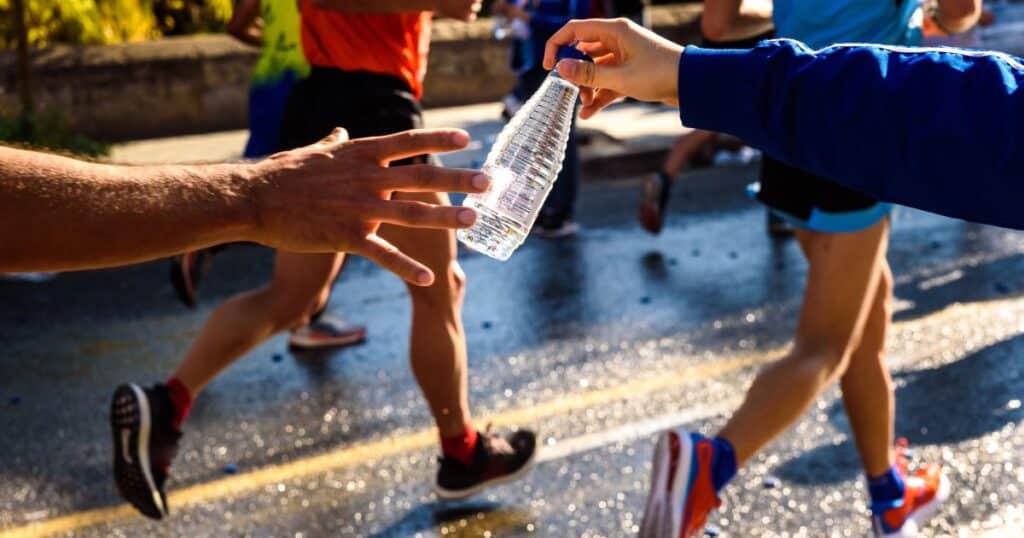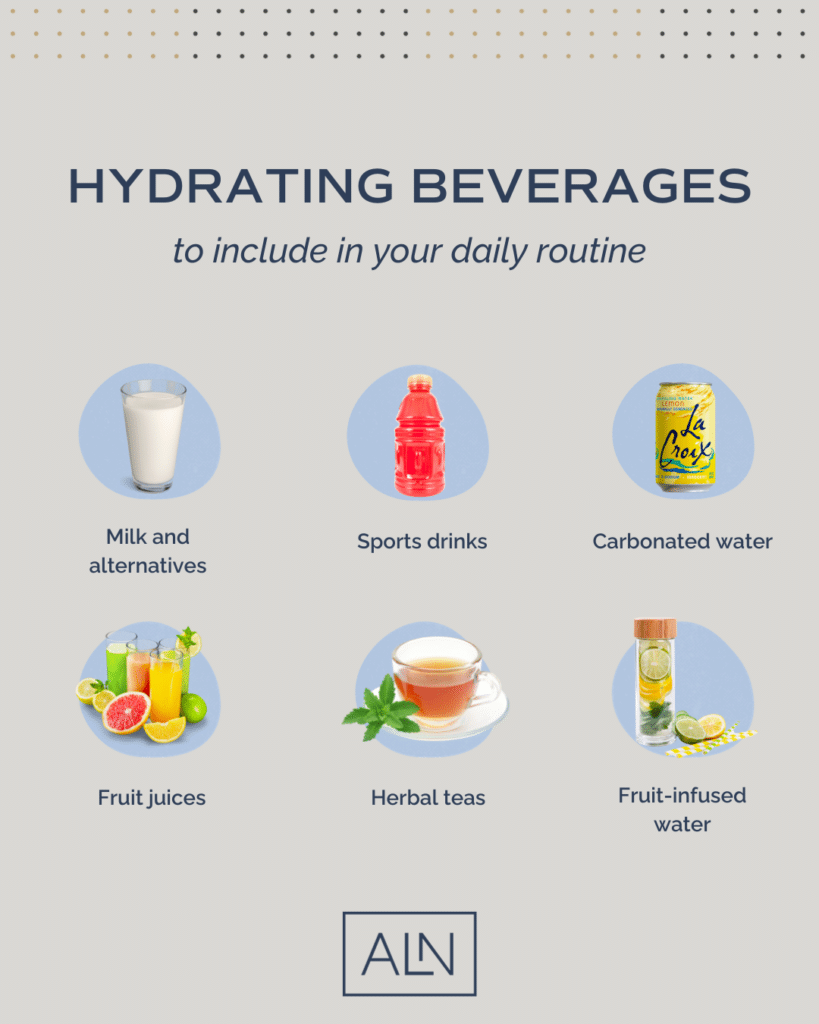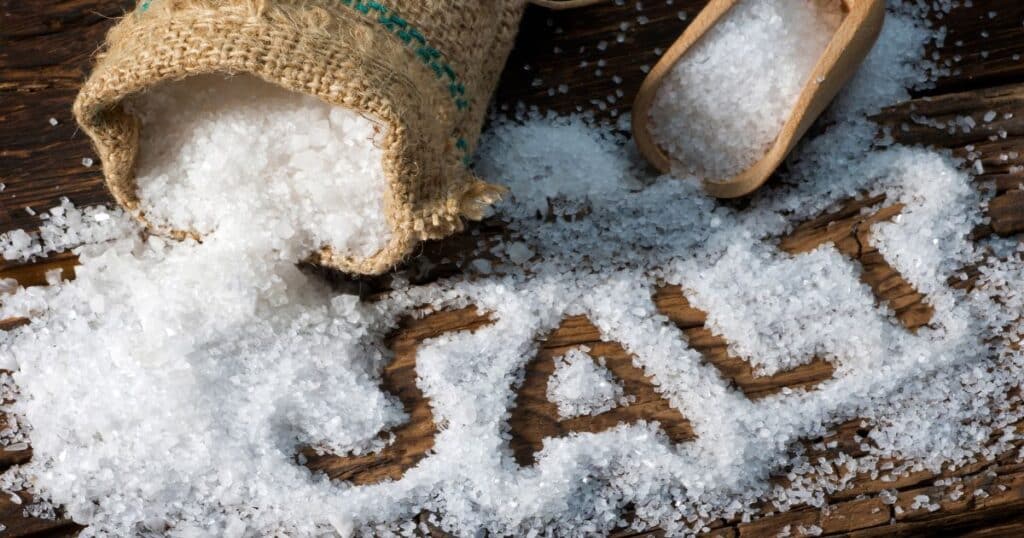Level Up Your Nutrition Game With Our Freebies
Alex
I provide nutrition coaching for endurance athletes to improve performance and body composition through a simple and flexible eating style.
Hi, I'm
ATHLETE EATING GUIDE →
LEARN MORE →
ATHLETE GROCERY SHOPPING GUIDE →
10-DAY PROTEIN-PACKED SAMPLE MEAL PLAN
READY TO FUEL?
incredible value!
The fueling guide bundle serves as your one-stop-shop for strategies to fueling before, during and after your workouts.
Endurance athletes are notable for pushing their bodies to extreme limits, subjecting themselves to intense physical challenges that demand more than just stamina. One common observation among many of our ALN athletes is the notably high concentration of salt in their sweat. This awareness of salty sweating not only sheds light on the body’s unique physiological response to exercise but also emphasizes the importance of proper hydration and electrolyte balance. Let’s take a deep dive into salty waters and guide you through important considerations for salty sweater endurance athletes.

Understanding Salty Sweater Endurance Athletes
If after a workout, you notice white streaks or crust residue on your skin or clothing, you are likely a salty sweater athlete. If your sweat tastes salty or stings your eyes while exercising, you are likely a salty sweater athlete. Other key factors to identify a salty sweater include:
- You feel faint or extreme weakness after exercise
- You experience muscle cramping during or post-exercise
- You constantly crave high-salt foods, particularly post-workout
If you deem yourself as a salty sweater, this means your sweat has a high concentration of salt. This makes it important to regularly consume enough salt to maintain proper body balance. If you do not adequately get in enough or replenish lost electrolytes from sweating, you will likely feel negative consequences. This includes chronic cramping or muscle spasms, frequent urination, headaches, confusion, nausea and unwanted gastrointestinal issues, and prolonged workout recovery.
Another method to formally measure sweat and electrolyte losses is doing a sweat test. This typically involves wearing a small patch while exercising. From this data, you receive an individualized report that shows your sweat losses and electrolyte losses, including salt, during exercise. Levelen is a company that I have worked with.
But First– The Importance of Hydration for Salty Sweaters
Being able to understand and assess your hydration is critical as an athlete. Proper hydration can prevent injury and illness, speed up recovery, and enhance overall performance. On the flip side, dehydration can occur when an athlete loses more water than they are consuming.
Especially in hot and humid conditions, or during prolonged exercise (>90 minutes), athletes can lose water at a rapid rate. If you aren’t actively replenishing with water and electrolytes, dehydration can creep up faster than you’d think.
So how does this affect sports performance? Well, we know that dehydration of even a 2% water loss can impair an endurance athlete’s performance. This is due to a variety of reasons, one being a decrease in blood volume and blood flow. With a lack of water, your blood starts to thicken and reduces its ability to transport nutrients and oxygen to your other cells.
A dehydrated athlete will not perform to the best of their ability. Science has shown us that staying hydrated can have many overall benefits for athletes.
Benefits of hydration for athletes include:
- Reduce fluid loss
- Improve cardiovascular outcomes such as a decrease in heart rate and maintaining blood volume
- Delay the onset of fatigue
- Prevent dehydration-associated injuries
- Less risk of heat stroke, stress, or illness
Additionally, hydration can be beneficial for other aspects of your health:
- Improve sleep quality
- Better mood and cognition
- Prevent infections and illnesses
- Lubricate joints
- Keep organs functioning properly
Baseline Hydration Goals

It is impossible to develop one-size-fits-all fluid and electrolyte guidelines due to the multiple factors that influence sweat rates and sweat electrolyte losses. General guidelines for athletes for total water intake daily are:
According to the National Academy of Sports Medicine, the recommended fluid intake for men is 125-130 oz/day (approx. 16 cups) and 91-95 oz/day (approx. 12 cups) for women
Remember that this number can increase depending on your training duration and intensity. When working with most of my endurance athletes, we tailor hydration goals based on individualized needs. To figure out your personal hydration needs as an endurance athlete, you can calculate your sweat rate, which tells you how much fluid you should aim to drink.
Action step: start tracking your fluid intake in an app or journal over the course of a few days and training sessions. This will give you a good starting point to go off of. Remember to include a wide variety of hydrating beverages in your daily routine. This includes water, carbonated water, fruit-infused water, milk and milk alternatives, sports drinks, decaffeinated or herbal teas, and fruit juices, among many others.

Hydration During Workouts
The timing of your hydration is a key component of your hydration status. When you should hydrate will depend on the duration of your session and the intensity or type of training you are performing. A bit of advanced planning is helpful so that you can hold yourself accountable for keeping hydrated.
Practical hydration guidelines for athletes around training sessions include:
- Consume 16oz fluids 1-2 hours before your session
- Continue to consume cool/cold liquids during your event. Aim for at least 5-10oz of hydrating fluids every 15 minutes during your training or race. This is particularly important for higher intensity or training sessions with longer durations
In and around your training sessions, there can be additional benefits to adding elements to your water such as electrolyte and hydration mixes and drinking sports drinks.
I’m a big fan of hydration mixes. They’re a powder mix that offers carbs, sugar, and electrolytes. A 3-in-1! The sugar and carbs provide on-the-go fuel and they typically contain a good amount of electrolytes to help you replenish the sodium lost through sweat.
Electrolyte mixes are also a great option. If you haven’t already, make sure to check out my full article on electrolytes for endurance athletes! I do a full comparison of some of the top electrolyte mixes and brands.
Hydration Post Workout
As our post-workout recovery blog post details, rehydration needs to be a top priority after a hard workout or race. Unfortunately, most athletes tend to replace only ½ or ¾ of their sweat losses through drinking during exercise. This lack of rehydration can increase the propensity for muscle cramping and also negatively affect post-workout recovery.
Remember to take advantage of beverages that have calories, carbohydrates, and electrolytes such as sports hydration beverages. Also remember that thirst is not always a reliable indicator of fluid losses, in fact tends to be a very late predictor of fluid needs. Also, a liquid meal can take the place of solid nutrition if you are feeling any sort of stomach upset. Certainly, review our tips for dealing with gastrointestinal distress if you are prone to this. Drinking cool water and fluids will help to lower core body temperature.

Sodium- the Key Electrolyte for a salty sweater
So based on you acknowledging the salt crusted to your head after an intense workout, you have deemed yourself as a salty sweater. It is now important to know that your electrolyte needs will vary based on your body size, training intensity, and duration of your workouts going forward. Another important factor to consider is the environment you are training in. The hotter and more humid the weather, the more electrolytes you will lose through sweat.
When it comes to intra-workout, if your workout is going to be longer than 90 minutes, it is recommended to take electrolytes in some form during your workout. Consider carrying an electrolyte drink or a single-serve powder mix packet that you can easily add to your water bottle. Current research suggests athletes can lose around 3500-7000 mg of sodium daily. If you are exercising less than two hours, it is recommended to consume 120-160 mg of sodium and 50-100 mg of potassium per 16-ounce serving of an electrolyte drink or water. If your training is longer than two hours, you will want to increase this amount.
Nutrition Strategies for Salty Sweaters
Fortunately, salty sweaters can replenish their electrolytes in a few ways. Utilizing electrolyte powders and sports drinks is increasingly common among endurance athletes. These powdered mixes are convenient options, especially when you are on the go.
Increasing your sodium consumption throughout the day is also easy by adding a few mealtime ingredients that are high in salt. This includes everyday favorites such as pickles, olives, salted nuts, beans, and high-salt condiments such as soy sauce and teriyaki sauce. Being extra generous with the salt shaker is also a great strategy. Be sure to optimize your intake of other important electrolytes including calcium, magnesium, and potassium.
Many of our clients have had a Levelen sweat test which shows extremely high concentrations of salt, some over 2000mg of sodium per hour. By adding high-salt electrolyte mixes and powders into their training and racing routine, they notice improved performance and decreased muscle soreness, tightness, and decreased recovery time. The benefits of regularly including electrolyte-rich foods and mixes into your routine can be rewarding so long as you are consistent with it!
Troubleshooting
It is important to note that specific health conditions and medications can increase the amount of sodium losses, including in sweat. If you are concerned with issues such as chronic cramping that is limiting your day-to-day functioning, it is best to seek medical care. Persistent muscle cramps that do not subside could imply a larger medical issue at hand. As always, my team and I are here to support you on your athletic adventures. Consider working with a sports dietitian so that you can better tailor a training and race day fuel plan that works well for you!
Alex
I provide nutrition coaching for endurance athletes to improve performance and body composition through a simple and flexible eating style.
Hi, I'm
LEARN MORE →
take the quiz!
Let's discover your Endurance Nutrition IQ
How well do you know your fueling? Answer these questions and let's see where your endurance nutrition knowledge is at!
Take the quiz
level up your nutrition game with these freebies
free downloadS
Protein-Packed 10-Day Sample Meal Plan
Athlete Eating Guide
Athlete Grocery Shopping Guide
1
2
3
Inspiration to fit 120 grams of protein into your day
Planning what goes on your plate
Putting the right foods in your grocery cart
